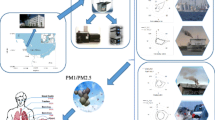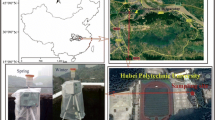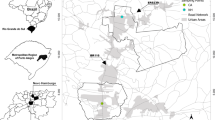Abstract
PM2.5 and PAHs bound to PM2.5 were investigated in downtown Bologna, from January to June 2003, in order to determine the burden of the fine fraction in the aerosol of a typical urban environment of the Po Valley, a critical area in Northern Italy in terms of atmospheric pollution. The sampling campaign was divided into three parts: a winter sub-campaign, an intermediate campaign where PM2.5 and PM10 were simultaneously sampled and which identified PM2.5 as the major component of PM10, and a summer sub-campaign. Critical concentrations of both PM2.5 and PAHs were observed in winter time; for example, in January 2003 the mean value for the 24-h average PM2.5 concentration was 58 μg/m3, much higher than the annual arithmetic mean of 15 μg/m3 established by the US ambient air quality standard (NAAQS). Correspondingly, the mean value for benzo[a]pyrene (BAP) in PM2.5 was 1.79 ng/m3, again higher than the annual mean of 1 ng/m3, required by European regulations for BAP in PM10. In summer time the BAP concentration considerably decreases to 0.10 ng/m3 as the likely effect of photolysis and dilution on a higher boundary layer; PM2.5 decreases too, but the mean concentration (22 μg/m3) is still higher than the NAAQS value. Further analysis included TEM microscopy of collected particles and correlations between PM2.5, PAHs and gases (benzene, O3, CO, NO2, SO2). All these observations identified on-road mobile sources as the main source of emissions and, in general, of the poor air quality level in the city of Bologna.
Similar content being viewed by others
References
Ancellet, G., & Ravetta, F. (2003). On the usefulness of an airborne lidar for O3 layer analysis in the free troposphere and the planetary boundary layer. Journal of Environmental Monitoring, 5, 47–56.
Berner, A., Galambos, Z., Ctyroky, P., Fruhauf, P., Hitzenberger, R., Gomiscek, B., et al. (2004). On the correlation of atmospheric aerosol components of mass size distributions in the larger region of a central European city. Atmospheric Environment, 38, 3959–3970.
Bidleman, T. F., & Harner, T. (2000). Sorption to aerosols. In R. S. Boethling & D. Mackay (Eds.), Handbook of property estimation methods for chemicals: Environmental and health sciences (pp. 233–260). New York: Lewis.
Bonasoni, P., Cristofanelli, P., Calzolari, F., Bonafe, U., Evangelisti, F., Stohl, A., et al. (2004). Aerosol-ozone correlations during dust transport episodes. Atmospheric Chemistry and Physics, 4, 1201–1215.
Chaloulakou, A., Kassomenos, P., Grivas, G., & Spyrellis, N. (2005). Particulate matter and black smoke concentration levels in central Athens, Greece. Environment International, 31, 651–659.
Commission of the European Communities (2005). Proposal for a directive of The European Parliament and of the Council on ambient air quality and cleaner air for Europe, (CAFE). Retrieved from http://ec.europa.eu/comm/environment/air/cafe/pdf/com_2005_447_en.pdf.
Decesari, S., Facchini, M. C., Matta, E., Lettini, F., Mircea, M., Fuzzi, S., et al. (2001). Chemical features and seasonal variation of fine aerosol water-soluble organic compounds in the Po Valley, Italy. Atmospheric Environment, 35, 3691–3699.
Donaldson, K., Jimenez, L. A., Rahman, I., Faux, S. P., MacNee, W., Gilmour, P. S., et al. (2004), Respiratory health effects of ambient air pollution particles: The role of reactive species. Oxygen/Nitrogen Radicals: Lung Biology in Health and Disease Series Volume. 187, New York: Marcel Dekker, 257–288.
Englert, N. (2004). Fine particles and human health - A review of epidemiological studies. Toxicology Letters, 149, 235–242.
European Commission (2001). The Working Group on polycyclic aromatic hydrocarbons, ambient air pollution by polycyclic aromatic hydrocarbons (PAH); Position Paper, July 27th 2001. Retrieved from http://europa.eu.int/comm/environment/air/pdf/pp_pah.pdf.
European Union (1999). Directive 1999/30/EC relating to limit values for sulphur dioxide, nitrogen dioxide and oxides of nitrogen, particulate matter and lead in ambient air. Official Journal of the European Communities L 163, 29/06/1999.
European Union (2005). Directive 2004/107/EC relating to arsenic, cadmium, mercury, nickel and polycyclic aromatic hydrocarbons in ambient air. Official Journal of the European Communities. L 23/3, 26/1/2005.
Gehrig, R., & Buchmann, B. (2003). Characterising seasonal variations and spatial distribution of ambient PM10 and PM2.5 concentrations based on long-term Swiss monitoring data. Atmospheric Environment, 37, 2571–2580.
Godlee, F. (1993). Air pollution II. Road traffic and modern industry. British Medical Journal, 303, 1539–1543.
Harrison, R. M., Smith, D. J. T., & Kibble, A. J. (2004). What is responsible for the carcinogenicity of PM2.5? Occupational & Environmental Medicine, 61, 799–805.
Heinrich, J., & Wichmann, H. -E. (2004). Traffic related pollutants in Europe and their effect on allergic disease. Current Opinion in Allergy and Clinical Immunology, 4, 341–348.
Lacasana, M., Esplugues, A., & Ballester, F. (2005). Exposure to ambient air pollution and prenatal and early childhood health effects. European Journal of Epidemiology, 20, 183–199.
Lippmann, M., Gordon, T., & Chen, L. C. (2005). Effects of subchronic exposures to concentrated ambient particles in mice: IX. Integral assessment and human health implications of subchronic exposures of mice to CAPs. Inhalation Toxicology, 17, 255–261.
Martuzzi, M., Galassi, C., Ostro, B., Forastiere, F., & Bertollini, R. (2002). Health impact assessment of air pollution in the eight major Italian cities, WHO – EUROPE EURO/02/5040650. Retrieved from http://www.euro.who.int/document/ E75492.pdf.
Natali, P., & Bollini, G. (2003). Lo Stato di qualità dell’aria, anno 2003. Ufficio AERE, Settore Ambiente della Provincia di Bologna. Retrieved from http://www.provincia.bologna.it/ambiente/documents/aria_2003/report_aria03. pdf.
Park, K., Cao, F., Kittelson, D. B., & McMurry, P. H. (2003). Relationship between particle mass and mobility for diesel exhaust particles. Environmental Science & Technology, 37, 577–583.
Park, K., Kittelson, D., & McMurry, P. (2004). Structural properties of diesel exhaust particles measured by transmission electron microscopy (TEM): Relationships to particle mass and mobility. Aerosol Science and Technology, 38, 881–889.
Petritoli, A., Bonasoni, P., Giovanelli, G., Ravegnani, F., Kostadinov, I., Bortoli, D., et al. (2004). First comparison between ground-based and satellite-borne measurements of tropospheric nitrogen dioxide in the Po basin. Journal of Geophysical Research [Atmospheres], 109, (D15), D15307/1–D15307/17.
Schaap, M., Van Loon, M., Ten Brink, H. M., Dentener, F. J., & Builtjes, P. J. H. (2004). Secondary inorganic aerosol simulations for Europe with special attention to nitrate. Atmospheric Chemistry and Physics, 4, 857–874.
Schwartz, J., Laden, F., & Zanobetti, A. (2002). The concentration-response relation between PM2.5 and daily deaths. Environmental Health Perspectives, 110, 1025–1029.
Simcik, M. F., Eisenreich, S. J., Franz, T. P., & Zhang, H. (1998). Gas-particle partitioning of PCBs and PAHs in the Chicago urban and adjacent coastal atmosphere: States of equilibrium. Environmental Science Technology, 32, 251–257.
Simcik, M. F., Eisenreich, S. J., & Lioy, P. J. (1999). Source apportionment and source/sink relationships of PAHs in the coastal atmosphere of Chicago and Lake Michigan. Atmospheric Environment, 33, 5071–5079.
Spindler, G., Müller, K., Brüggemann, E., Gnauk, T., & Herrmann, H. (2004). Long-term size-segregated characterization of PM10, PM2.5, and PM1 at the IfT research station Melpitz downwind of Leipzig (Germany) using high and low-volume filter samplers. Atmospheric Environment, 38, 5333–5347.
Spirig, C., Neftel, A., Kleinman, L. I., & Hjorth, J. (2002). NO x versus VOC limitation of O3 production in the Po Valley: Local and integrated view based on observations. Journal of Geophysical Research [Atmospheres], 107, (D22), LOP4/1–LOP4/19.
Stracquadanio, M., Bergamini, D., Massaroli, E., & Trombini, C. (2005). Field evaluation of a passive sampler of polycyclic aromatic hydrocarbons (PAHs) in an urban atmosphere (Bologna, Italy). Journal of Environmental Monitoring, 7, 910–915.
Trasande, L., & Thurston, G. D. (2005). The role of air pollution in asthma and other pediatric morbidities. Journal of Allergy and Clinical Immunology, 115, 689–699.
US EPA (1993). Provisional guidance for quantitative risk assessment of polycyclic aromatic hydrocarbons. EPA/600/R–93/089.
US EPA (1997). Fine particle (PM2.5) designations. Regulatory action. 62, Federal Register 38652–38896, July 18. Retrieved from http://www.US EPA.gov/pmdesignations/ regs.htm and http://www.US EPA.gov/pmdesignations/ documents/Apr05/factsheet.htm.
US EPA (1999). US EPA method 610, Polynuclear Aromatic Hydrocarbons. Retrieved from http://www.accustandard.com/asi/US EPA_downloads.php3.
WHO (1983). IARC Monographs on the evaluation of the carcinogenic risk of chemicals to human. Polynuclear aromatic compounds. Vol. 32.
WHO (1996). Environmental health criteria 171. Diesel fuel and exhaust emissions. Geneva: World Health Organization, 1996.
Author information
Authors and Affiliations
Corresponding author
Rights and permissions
About this article
Cite this article
Stracquadanio, M., Apollo, G. & Trombini, C. A Study of PM2.5 and PM2.5-Associated Polycyclic Aromatic Hydrocarbons at an Urban Site in the Po Valley (Bologna, Italy). Water Air Soil Pollut 179, 227–237 (2007). https://doi.org/10.1007/s11270-006-9227-6
Received:
Accepted:
Published:
Issue Date:
DOI: https://doi.org/10.1007/s11270-006-9227-6




